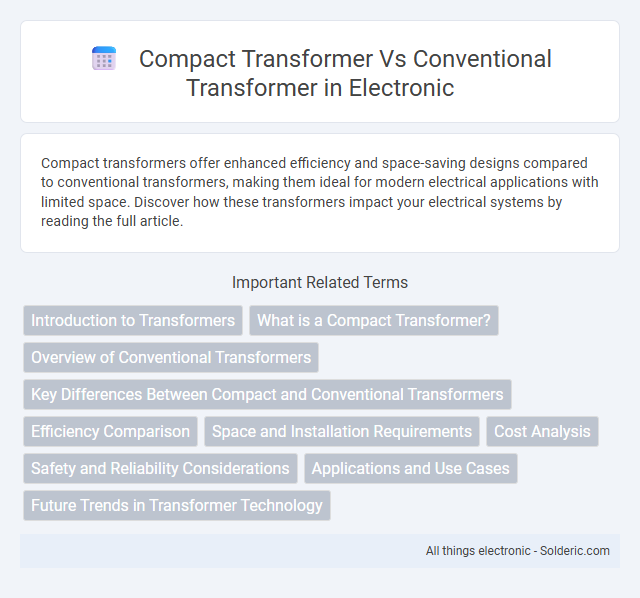Compact transformers offer enhanced efficiency and space-saving designs compared to conventional transformers, making them ideal for modern electrical applications with limited space. Discover how these transformers impact your electrical systems by reading the full article.
Comparison Table
| Feature | Compact Transformer | Conventional Transformer |
|---|---|---|
| Model Size | Smaller, fewer parameters | Larger, more parameters |
| Computational Efficiency | High, optimized for low resource use | Lower, requires significant computation |
| Speed | Faster training and inference | Slower due to complexity |
| Performance | Competitive on standard benchmarks | State-of-the-art on complex tasks |
| Use Cases | Edge devices, mobile NLP, resource-limited scenarios | Data centers, large-scale NLP, complex modeling |
| Architecture | Simplified layers, parameter sharing | Deeper, more layered attention mechanisms |
| Memory Consumption | Lower memory footprint | High memory demand |
Introduction to Transformers
Transformers convert electrical energy between circuits through electromagnetic induction, playing a crucial role in voltage regulation and power distribution. Conventional transformers feature larger cores and coils, resulting in increased weight and size. Your choice of a compact transformer offers advantages such as reduced space requirements and improved efficiency in modern electrical systems.
What is a Compact Transformer?
A compact transformer is a smaller, more efficient version of a conventional transformer designed to save space while maintaining performance. It uses advanced materials and optimized winding techniques to reduce size and weight without sacrificing voltage regulation or power capacity. Your choice of a compact transformer can improve installation flexibility and reduce overall system footprint in electrical applications.
Overview of Conventional Transformers
Conventional transformers operate on the principle of electromagnetic induction, using iron cores and copper windings to transfer electrical energy between circuits with high efficiency. They are typically larger and heavier due to their extensive coil windings and laminated steel cores, which are designed to handle high voltage and current levels reliably. Your choice between a compact transformer and a conventional transformer will depend on factors such as space constraints, efficiency requirements, and application-specific power ratings.
Key Differences Between Compact and Conventional Transformers
Compact transformers feature a smaller footprint and higher efficiency due to advanced core materials and design optimization, whereas conventional transformers generally have bulkier cores and simpler construction. Compact transformers utilize improved insulation and cooling techniques, enabling higher power density and reduced energy loss compared to conventional models. Maintenance requirements for compact transformers are often lower because of their robust design and enhanced thermal management systems relative to traditional transformers.
Efficiency Comparison
Compact transformers typically achieve higher efficiency than conventional transformers due to advanced core materials and optimized winding designs that reduce core and copper losses. Their smaller size and improved heat dissipation also contribute to lower energy wastage during operation, enhancing overall performance. When selecting a transformer, you should consider compact transformers for applications where reducing energy consumption and improving efficiency are critical.
Space and Installation Requirements
Compact transformers significantly reduce space and installation requirements compared to conventional transformers due to their smaller footprint and advanced design. These transformers use high-quality core materials and optimized winding techniques, allowing for efficient performance in confined spaces. Their compact size enables easier integration into residential, commercial, and industrial settings where space limitations are critical.
Cost Analysis
Compact transformers typically offer significant cost savings compared to conventional transformers due to reduced material usage and smaller size. Your installation costs also decrease since compact transformers require less space and simpler mounting infrastructure. Lower transportation and maintenance expenses further enhance the overall affordability of compact transformers in various applications.
Safety and Reliability Considerations
Compact transformers offer enhanced safety features through improved insulation materials and advanced thermal management, reducing risks of overheating and electrical faults compared to conventional transformers. Their design often incorporates sealed enclosures that minimize exposure to environmental contaminants, increasing reliability in harsh conditions. Your choice of a compact transformer can lead to fewer maintenance issues and longer operational lifespan due to these safety and reliability advantages.
Applications and Use Cases
Compact transformers are widely used in portable electronic devices, LED lighting, and low-power industrial equipment due to their smaller size and enhanced energy efficiency. Conventional transformers remain essential in high-power applications such as electrical substations, large motor drives, and power distribution systems where durability and higher load capacity are critical. The choice between compact and conventional transformers depends on factors like space constraints, power rating, and specific application requirements across consumer electronics and industrial sectors.
Future Trends in Transformer Technology
Compact transformers are gaining traction due to advancements in materials like amorphous steel and innovative cooling techniques that enhance efficiency and reduce size compared to conventional transformers. Future trends emphasize integrating smart sensors and IoT connectivity for real-time monitoring, predictive maintenance, and improved grid reliability. Your power infrastructure will benefit from these developments, offering more sustainable and cost-effective solutions as the demand for renewable energy and decentralized power systems grows.
compact transformer vs conventional transformer Infographic

 solderic.com
solderic.com